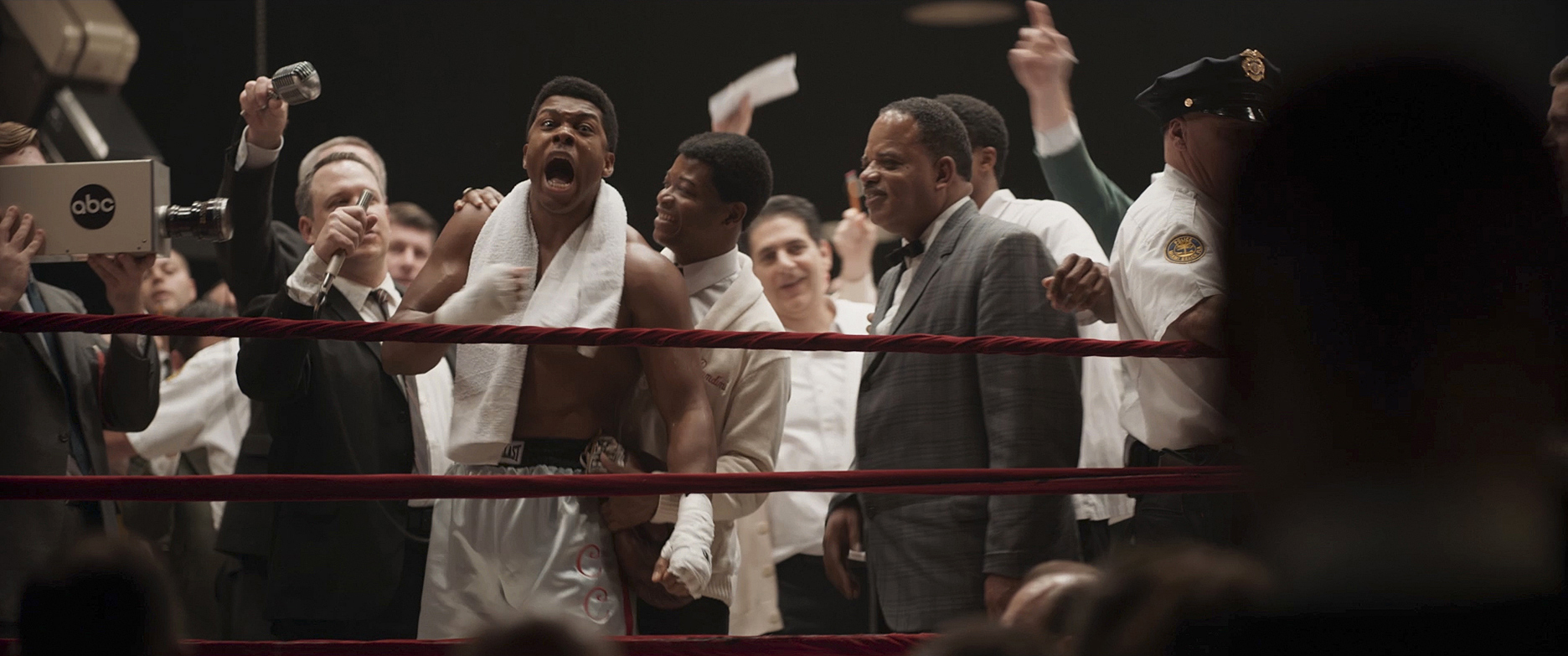
Tipping Point: One Night in Miami
Cinematographer Tami Reiker, ASC and director Regina King capture cultural icons on the brink of transformation.

Behind-the-scenes photos by Patti Perret. All photos courtesy of Amazon Studios
It’s a little-known fact that after Cassius Clay wrenched the World Heavyweight Champion title from Sonny Liston in a stunning upset, he spent a quiet evening in his Miami hotel room with his friends Malcolm X, singer Sam Cooke and NFL champ Jim Brown. When playwright Kemp Powers learned of this from a book about the intersection of sports and the civil rights movement, he was inspired to write a stage play, and then a screenplay, that imagined what the men discussed over the course of that evening.
The year was 1964, and each of the four men was on the verge of a major transition. Clay was about to become a Muslim and take the name Muhammad Ali; Malcolm X was preparing to break from the Nation of Islam and start his own organization; Cooke was pivoting toward socially relevant songs such as “A Change Is Gonna Come,” and Brown was about to retire from football and pursue an acting career.
The feature One Night in Miami gives equal weight to all four, but it’s Clay who first draws the viewer in. The movie kicks off with an earlier fight in London, one of the few times Clay was knocked down. “We enter the film feeling like it’s Cassius’ story — that’s what grabs you,” says director Regina King.
“It was important for Regina to keep
the historical references to actual events
and locations.”
— Tami Reiker, ASC
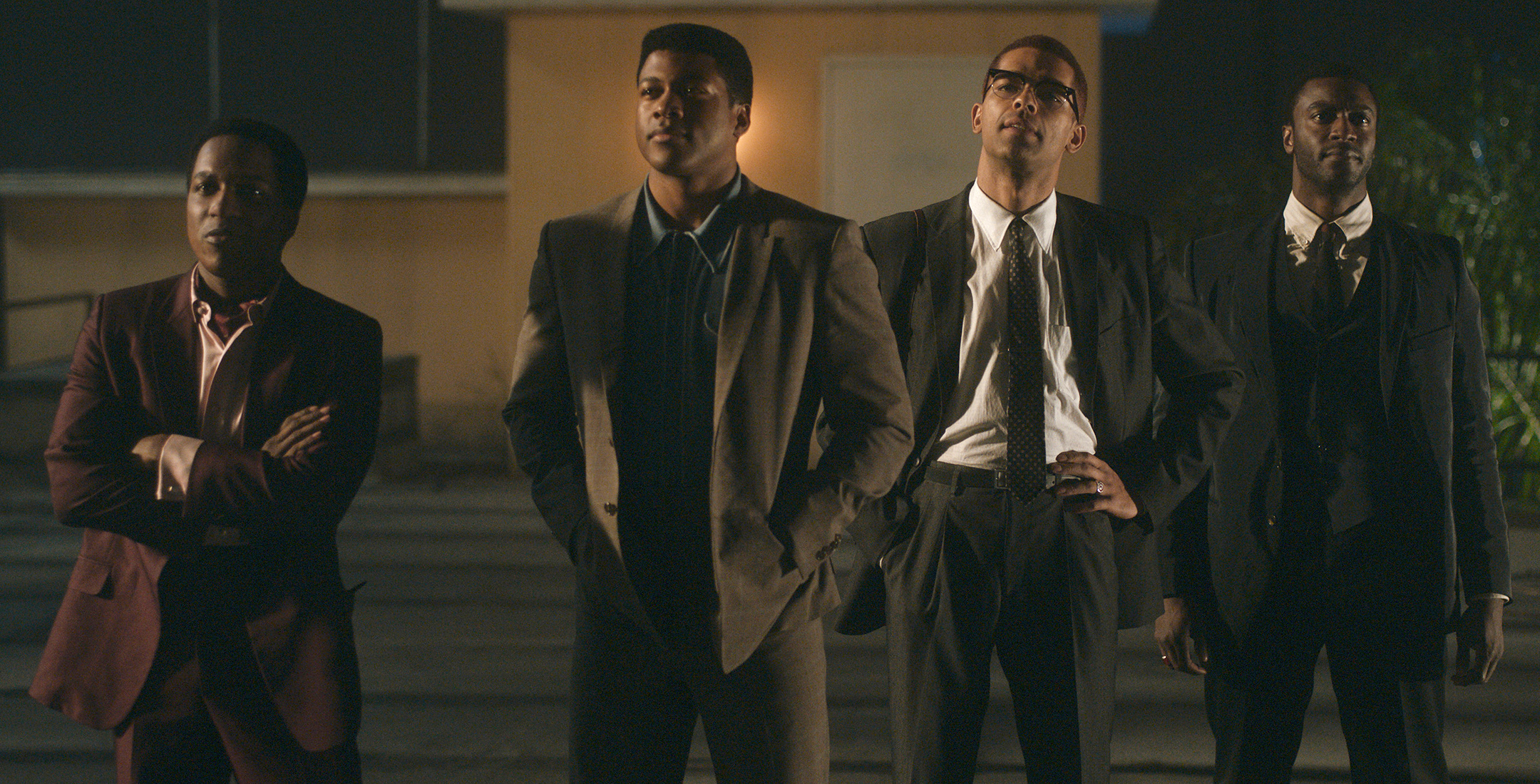
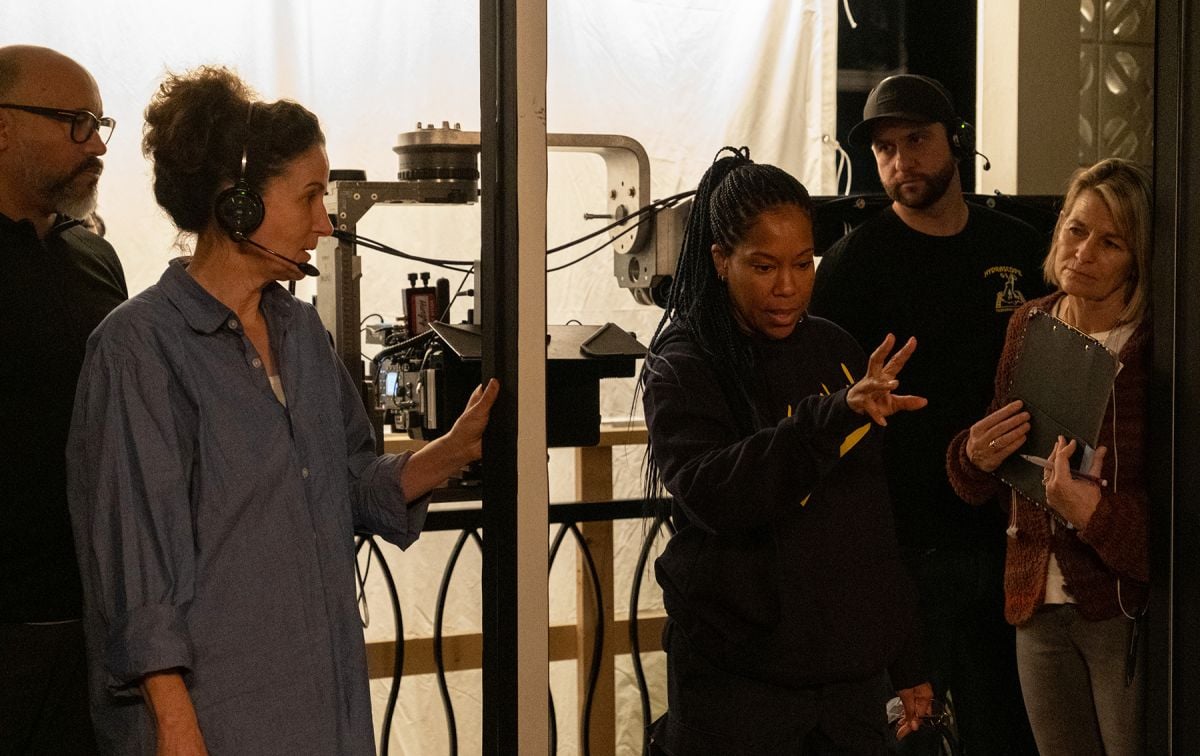
King had clear ideas about the production’s look: Keep the camera moving, create an immersive experience, use vibrant colors, and respect history. “It was important for Regina to keep the historical references to actual events and locations,” says cinematographer Tami Reiker, ASC, who was working with the director and Oscar-winning actor for the first time. (Reiker calls King “a powerhouse and an incredible collaborator.”) Historical accuracy was paramount not only in the fights, but also in various scenes based on iconic photographs. These include Clay posing underwater in a perfect boxer’s stance; the tuxedoed boxer holding court in a diner after the Liston fight; overhead shots of spectators rushing into a ring, post-knockout; Brown announcing his NFL retirement on the set of The Dirty Dozen; and Cooke debuting “A Change Is Gonna Come” on The Tonight Show.
Another priority was bold color. “I told Tami that Black people are so vibrant,” King says. “We’re like the most resilient beings because we’ve been through so much, but we still manage to dance, to smile, to sing, to have an energy that comes off of us that’s so colorful. I wanted to capture that without it feeling like a musical.” Her touchstone was Jacob Lawrence, known for his colorful mid-century paintings of African-American life.
Prior to her interview with King, Reiker sent the director a lookbook packed with color. Street photographers Saul Leiter and Garry Winogrand were in the mix, as were stills from Wong Kar-wai’s In the Mood for Love (AC Feb. ’01). “What I presented was a very rich and saturated look,” Reiker recalls. “I wanted to show the vibrancy of Miami at night. We chose a vibrant blue to contrast with the warm tungsten interiors of the hotel room.”
“How do we come up with frames that are going to put an ‘exclamation mark’ on a moment?
That takes time to find.”
— Regina King
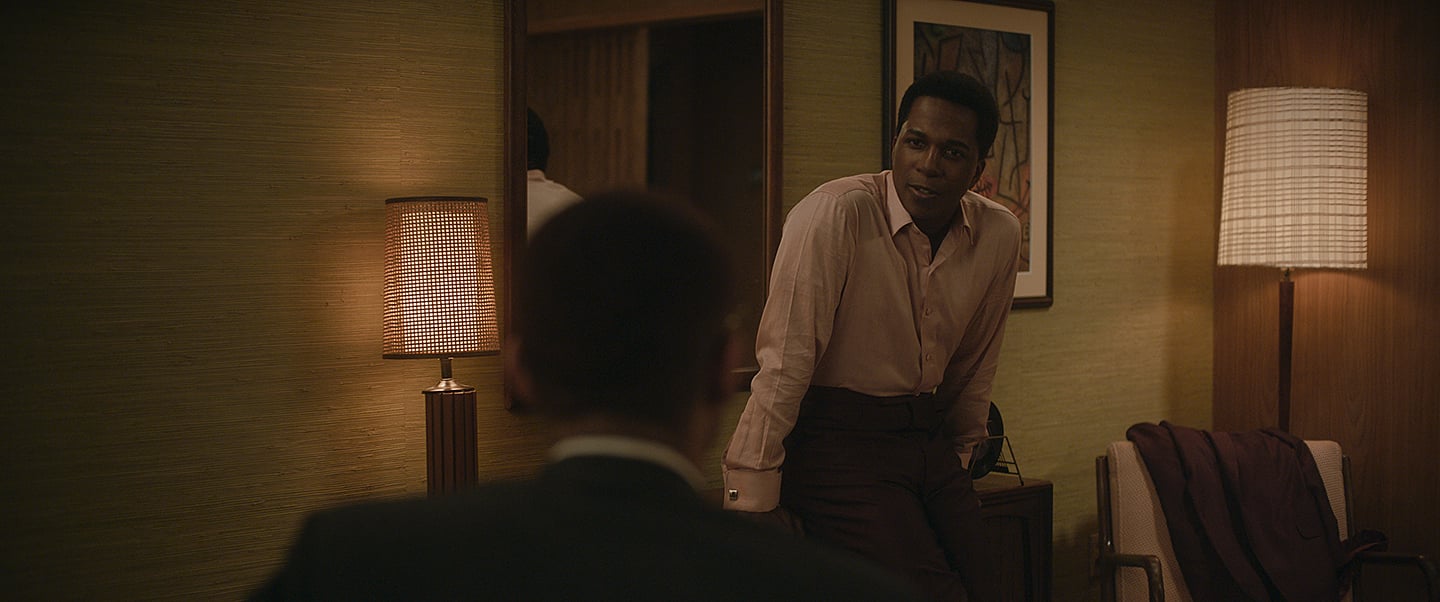
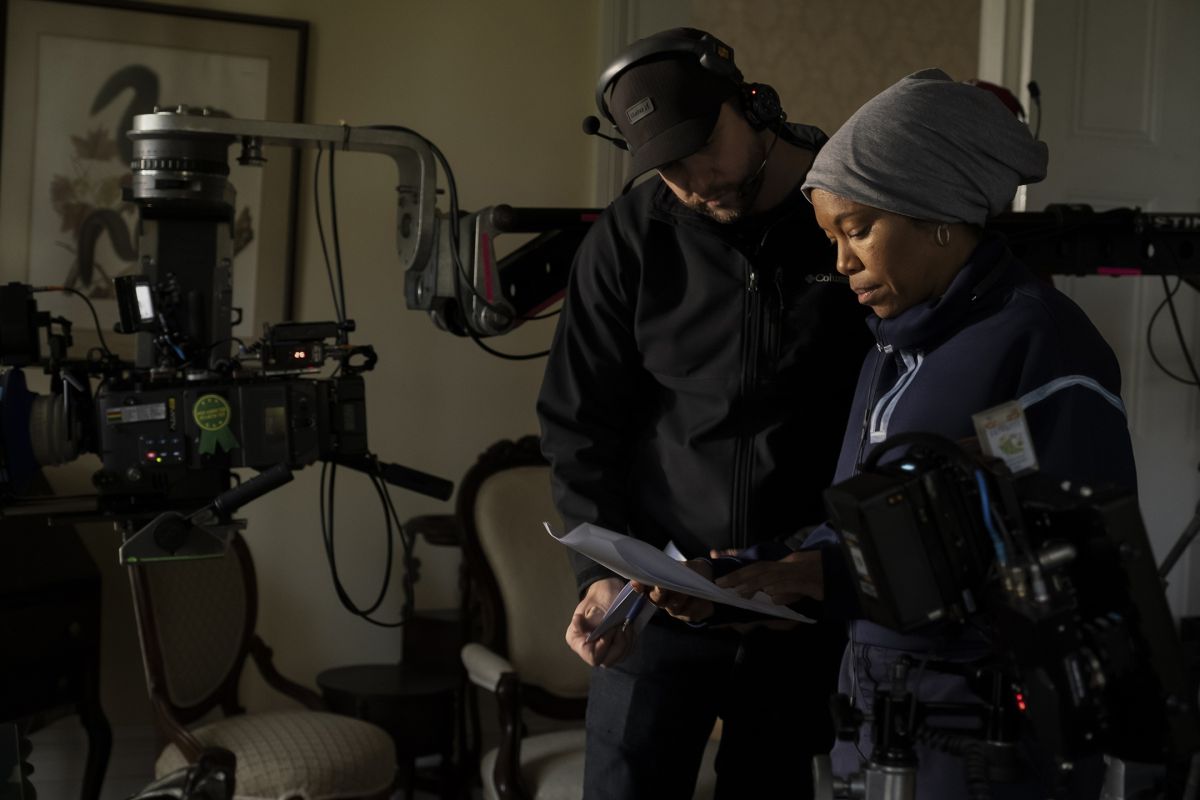
Another guiding principle: “We wanted to make it a very immersive experience,” Reiker says. That affected everything from choice of format, to shooting long takes, to letting shots run in the edit.
Reiker pushed for an Arri Alexa 65 and a 2.39:1 aspect ratio after her positive experience with it on The Old Guard. “It’s just so beautiful, the falloff you get, and it [creates] an immersive experience for the audience. You feel like you’re right in there.”
The production didn’t have the budget for large format, but Reiker pleaded her case with Arri Rental in Burbank anyway. “I did my whole song and dance about how amazing it would be,” she recalls. “Arri was fantastic. They said, ‘We’ll make this happen. We want filmmakers to know the 65 isn’t just for big action movies or superhero movies; it’s also for small, intimate movies.’”
The production obtained two Alexa 65 cameras and an Alexa Mini LF, as well as Arri Prime DNA lenses, which Reiker chose for their speed, softness and falloff. She used a Tiffen Bronze Glimmerglass 1 filter on the lens throughout the shoot. “It added a warmth to the overall feel and also a warmth to the skin tones,” she says.
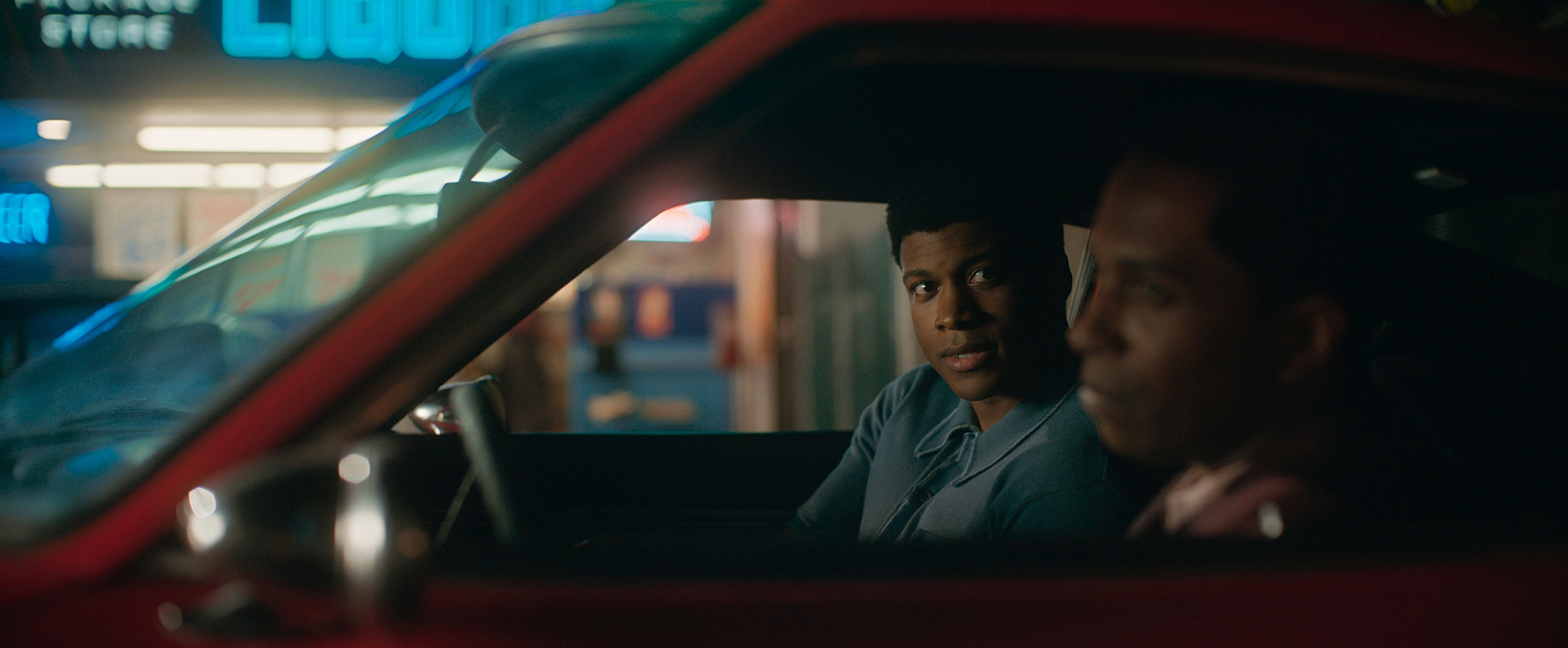
Though One Night in Miami was King’s feature-directing debut, it was not her first go-round in the director’s chair. She had helmed numerous television projects — a mix of movies, pilots and episodes — but this time, she says, “my choice was not to lean on extreme close-ups to make a point for a piece of dialogue or an intention in a scene, because I didn’t feel it complemented the large format. So, how do we come up with frames that are going to put an ‘exclamation mark’ on a moment? That takes time to find.” With a 30-day schedule, however, time was not on their side.
Their solution tied into another of the director’s priorities — a constantly moving frame — and Reiker’s way of achieving that. “Because the majority of the film takes place in the hotel room, I felt it was visually important to not feel static,” King says. “I wanted to keep the energy going because these men have so much life. I wanted to always feel like there was movement, but I didn’t want the camera to be a distraction.”
Reiker adds, “We had these 10- and 12-page scenes, many of them just wall-to-wall dialogue. That was very daunting.”
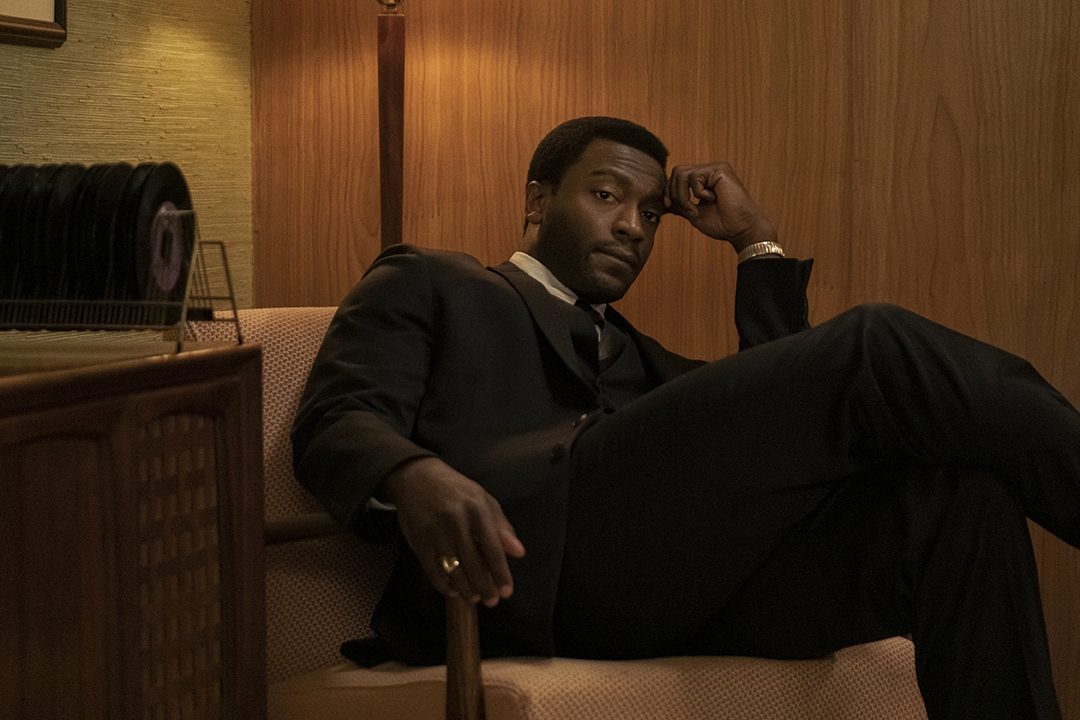
Two such scenes were set inside the Hampton House Motel, and one unfolds on the roof. For the interior Hampton House sets — constructed in a rec-center-turned-stage in LaPlace, La., outside New Orleans — Reiker notes, “We wanted to keep the camera floating and drifting so we’d be constantly shifting perspectives. I presented this idea of keeping the camera on a jib arm but manually operated, not on a hothead. We had each 65 on a [J.L.] Fisher 10 dolly with a 12-foot jib arm and an underslung Cartoni Lambda head. [A-camera operator] Chad Chamberlain and [B-camera operator] Austin Alward could swing and drift and get to every corner of that hotel room. We could go from 2 feet to 10 feet in one move, and it was the operators making that decision, so it could be very organic.”
Every painting and mirror in these interiors had what Reiker calls a “hidey hole” behind it so a jib arm could poke through. “Everything except the back of the hotel could pop in and out,” she notes. “So if A camera was in the room, B camera could still be getting the full movement of the jib arm through the holes that were cut out without having to pull the wall” — a big timesaver.
On these long, dialogue-heavy scenes, the strategy was to shoot takes of 10 to 15 minutes. The actors loved it because it allowed them time to fully ramp up. It also helped with the edit. “We didn’t want to have the film all cut up,” says Reiker. And although it was challenging for her crew, “the material was intense, so shooting it this way was as immersive an experience for us as we wanted it to be for the audience!”
By its very nature, the camera strategy made lighting tricky, especially because the hotel room had a low ceiling. “We had to use very low-profile lights, mainly on the ceiling,” Reiker says. “We used Astera Titan and Helios [LED] tubes with Honeycrates and fabric grids. They were rigged in all four corners of the room, and after we watched rehearsal, we’d decide which ones we’d use. For fill, we used a baby scoop light made by [gaffer] Allen Parks; it was a 10-inch metal disc with LiteGear bi-color LED cards and Magic Cloth diffusion over the top, and we added snoots and honeycomb grids. That allowed us to have a tight fill light on our actors without overpowering the set walls.” She gelled the Astera tubes with 1/4 CTO and dimmed the practicals, lamped with 40-watt tungsten bulbs, “to a nice warm hue.”
Reiker adds appreciatively, “The latitude with a 6K camera is really incredible. You can underexpose in the shadows [while] bringing out people’s faces. In the hotel room, that was invaluable.”
For exteriors, Reiker created what she calls “Miami blue” by dialing in something close to Rosco Cyan 60 on the Arri SkyPanels that lit the hotel exterior and pool, as well as a liquor store in Los Angeles.
In contrast to the camerawork in the hotel interiors, King wanted a different energy for the 12-page scene on the hotel roof. At that point in the story, Reiker explains, “they’ve been in that hotel room, and Malcolm is getting paranoid that he’s being watched and bugged. They just needed to bust out and get a breath of fresh air. As they did that, we went handheld, and we stayed handheld for the entire scene so we could move with them and feel the energy.”
That energy, however, turns from relief to tension. Says King, “Just as we’re thinking it’s like summer camp, with the boys on the roof watching the fireworks, it starts to get a little crazy when that conflict between Sam and Malcolm starts to go.” Thus begins one of the movie’s many arguments about whether Black artists and athletes should be “weapons” in the cultural fight, as Malcolm X insists, or whether economic power is key. Cooke, who owned his own record label, says at one point, “I don’t want a piece of the pie — I want the recipe.”
The filmmakers wanted to shoot the roof scene outside but keep blue- or greenscreen to a minimum. They had trouble finding the right roof; most of the buildings nearby had low parapets that would require safety harnesses on the actors. So instead, the crew built a roof atop shipping containers in a parking lot next to the stage. Being 10' up, they needed a guardrail, but that could be a thin, black bar that was easy to disguise in the dark.
The production split the rooftop shoot over two nights. When the actors faced the Miami skyline and the fireworks display, they had a bluescreen. Then that came down, and they shot in the opposite direction the next night. To suggest the surrounding environment, Reiker says, “I put small, battery-operated lights and neon a quarter- or half-mile in the background to create the feeling of light back there.”

Ready to Rumble
The two boxing matches in the story don’t occupy much screen time‚ but the filmmakers knew it was important to get those sequences right — after all, anybody can watch the actual fight footage on YouTube. The production thus faithfully replicated the fight choreography, costumes, height of the ring, lighting grids, and myriad other details.
The first fight opens with a crane shot telescoping in over the crowd at Wembley Stadium. Londoners were rooting for Henry “The Hammer” Cooper, who was heavily favored to win. At that point, Clay was mostly known as a big talker, but he quickly proved the superior boxer, pummeling his opponent and ultimately — though it’s not shown in the movie — winning the fight. However, Cooper managed to land a hammer-fisted blow that knocked down the overly confident American.
Odds were against Clay in Miami, too. There he was pitted against Liston, a seemingly invincible boxer with ties to organized crime. Clay was still considered a braggart and a showboat, but he gave more than he got. After the sixth round, a bloodied Liston pointed to his injured shoulder and threw in the towel. That moment marked Clay’s transformation into “The Greatest.”
Reiker used both Alexa 65s and the Mini LF (the latter modified to LPL mount to use the Prime DNAs) on both fights. Two cameras were outside the ring on longer lenses, capturing “dirty frames” over the crowd and through the ropes. Chamberlain was inside the ring, holding the A camera at waist height. “That gave you more of a feeling of being in the ring,” Reiker says. The low angle also meant that overhead lights were sometimes visible, and Reiker’s crew meticulously reproduced the respective lighting grids for each fight. “Allen Parks was able to source the 18-inch Altman 1K scoops that were actually used for [the Miami] fight,” she says. “He found them collecting dust in a corner at MBS Equipment in Burbank.”
Parks obtained 30 of them and replicated a seemingly random grid in the Miami fight. “There were a lot of lights up that were never actually turned on,” says Reiker. “So we re-created that whole grid and raised it up above the fight. The bounce off the white mat [in the ring] lit the entire set, plus the first three or four rows of the audience.”
Reiker used the same Altman scoop lights for Wembley, just on a lesser scale. That arena “was much tighter, much smaller, and the fight took place right at sunset, so it went from dusk into night.” She also distinguished the fights by smoking up the first one but not the second. In addition, many of the 200 extras in the Miami scene were popping off flashbulbs. “We had hundreds of those flash cubes,” says Reiker, noting that visual effects extended the effect deeper into the crowd.
Hero Fight
When it came to the Wembley and Miami fights, King wryly sums up the filmmakers’ challenge: “How do we make the two fights feel different with the limitations we were under, these being money and money? And how do we make Miami feel like the hero fight?” The fact that both fights were shot in the same place, Second Line Stages in New Orleans, made it tougher still.
One key reference was the book Greatest of All Time: A Tribute to Muhammad Ali. “That really became our bible for the Miami fight,” Reiker says. Among its photos was an overhead series looking down on the ring after a knockout. Though the image was from a different fight, King knew she’d struck gold. “I thought [that would] make this feel like a heroic moment without having to lean on extras,” she recalls. “This image makes it feel like God’s watching over. It’s the biggest moment in his career.”
The same Technocrane 45 that telescoped over the Wembley crowd was used to get this climactic overhead in Miami. The production could only afford limited hours with the crane, however. King notes, “This is not a film where you have a bunch of cinematic-type shots, so when we were creating those moments and [with] such a time constraint, it did create a lot of anxiety. At least, it did for me.”
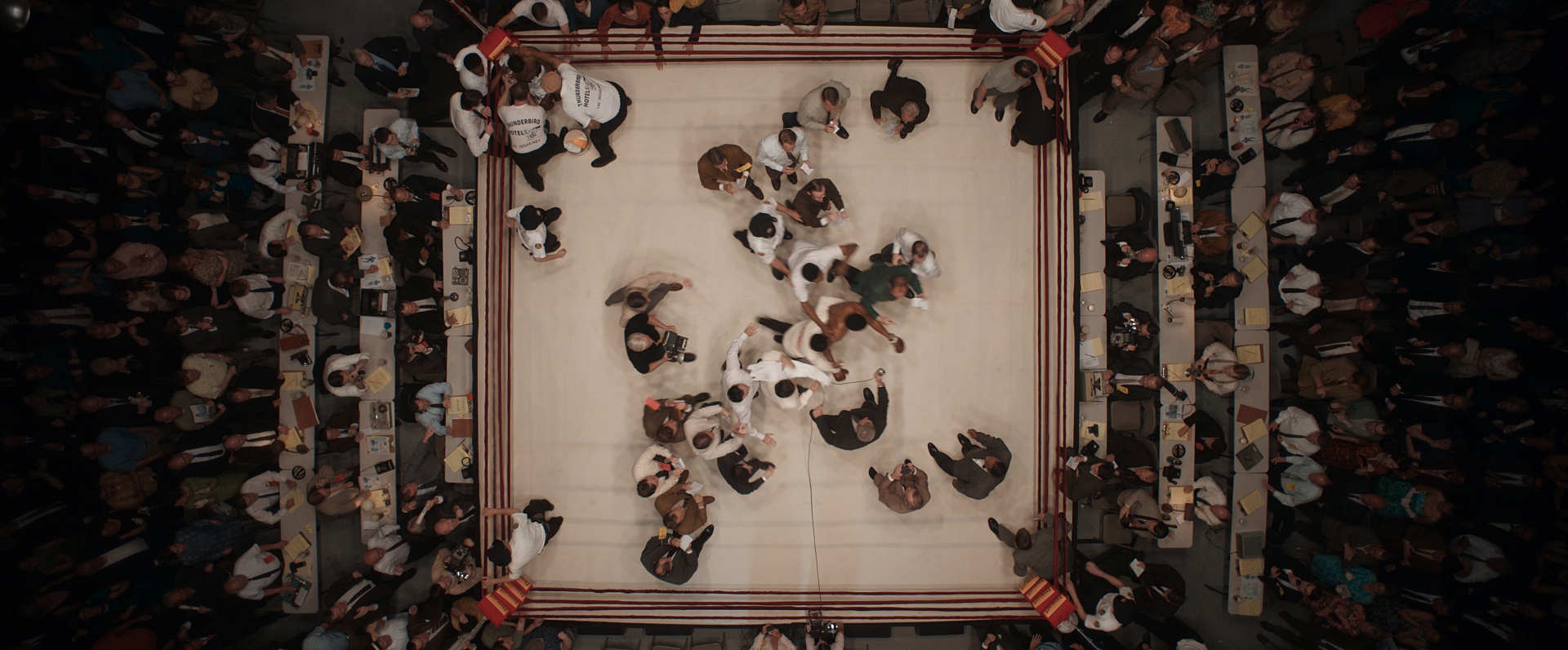
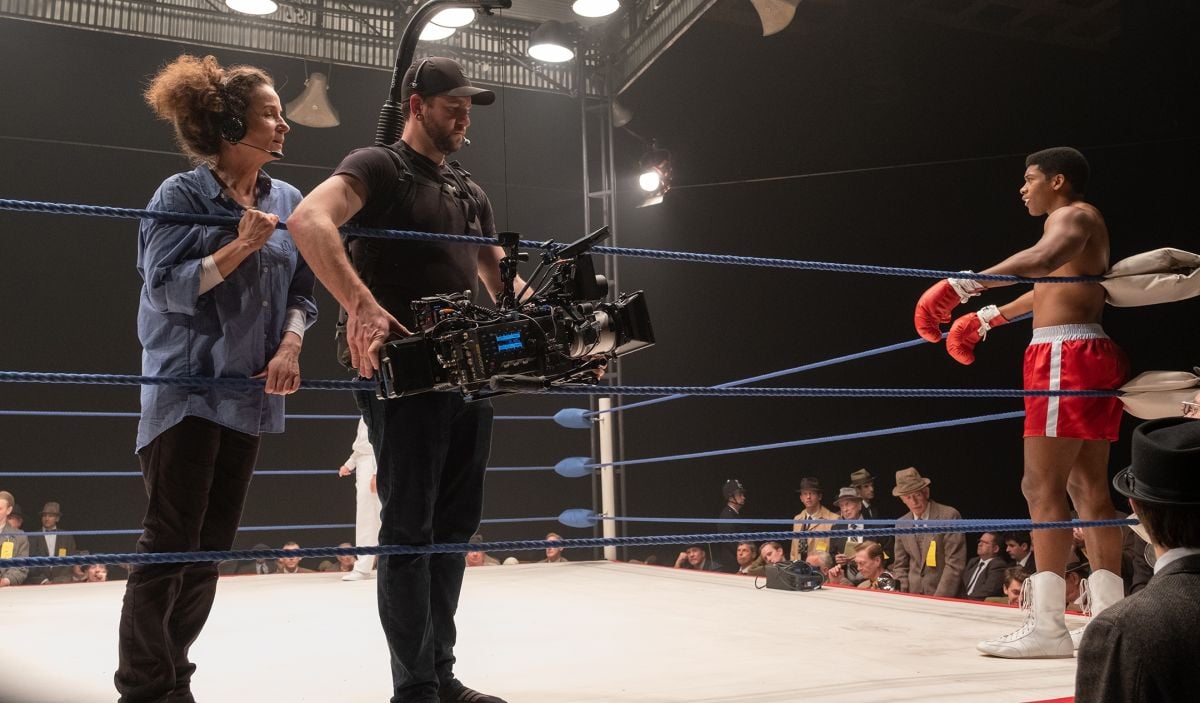
Final Rounds
The bulk of One Night in Miami was shot in January and February 2020. (The two remaining scenes were shot in L.A. in June as soon as production was permitted to restart following the lockdown.) By the time the final grade rolled around, Amazon had bought the feature, “so that extra money bought us a little extra time,” Reiker says. She, King and the producers spent three weeks at Light Iron in Los Angeles working with colorist Ian Vertovec, who used a FilmLight Baselight system. The filmmakers sat in one theater and Vertovec in another, and they viewed the same screen. “We talked to Ian using Google Meet on an iPad and laser pointers,” Reiker recalls. “Other than that, it was the regular color-correction experience. We could include VFX from all over the world on the Google Meet, so we were all watching the same image, which proved incredibly helpful.”
Although the movie takes place in 1964, its nuanced and passionate debates about race, responsibility and power continue today. “Fifty years later, those complications still resonate, now more than ever,” Reiker says. “It was such an experience to be in that hotel room and listen to this dialogue. Chills down your back!”
With a laugh, she adds, “There was one point when Malcolm was speaking to Sam Cooke in one of his lectures, and the dolly grip was so into the moment, he yelled, ‘That’s right!’ Then he looked horrified! But that’s how everyone felt. We were all watching incredible performances and just hanging on their every word.”
TECH SPECS
2.39:1
Camera: Arri Alexa 65, Mini LF
Lenses: Arri Prime DNA
Patti Lee, ASC later interviewed Reiker for the ASC’s Clubhouse Conversations discussion video series:






